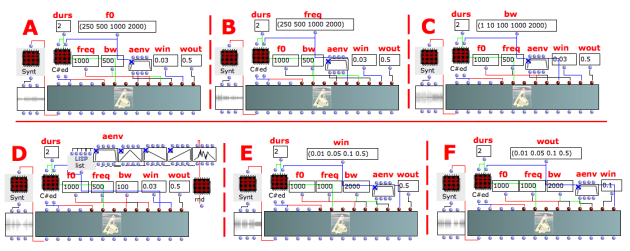Random Amplitude Modulation Synthesys with RANFL-1
Tutorial RANFL-1
Name | Description | Default value |
|---|---|---|
amp | Maximum Amplitude. Linear from >0.0 to 1000 or in dB from 0 to -∞ (see Tutorial Getting Started 02 - Amplitude and Internal Editor for more details) | -6.0 |
f0 | Maximum frequency of the Random Amplitude Modulation or of the generating noise [Hz] | 263.8 |
freq | Center frequency of the formant-resonant filter [Hz] | 1600.0 |
bw | Bandwidth of the formant-resonant filter [Hz] | 500.0 |
aenv | Amplitude Envelope [GEN] | Instance: GEN07 |
win | Impulse response attack time [sec] | 0.03 |
wout | Impulse response decay time [sec] | 0.3 |
The RANFL-1 Class realizes a Random Amplitude Modulation of a Formant-Resonant Filter with the following controls:
- The main amplitude,
- The maximum frequency of the Random Amplitude Modulation or of the generating noise,
- The center frequency of the formant-resonant filter,
- The bandwidth of the formant-resonant filter,
- The amplitude envelope by means of a GEN routine,
- The Impulse response attack time,
- The Impulse response decay time.
The example A focuses on the maximum frequency of the Random Amplitude Modulation.
The example B deals with the center frequency of the formant-resonant filter.
The example C spreads the bandwidth of the formant-resonant filter from 1 to 2000 Hz.
The example D collects 5 different amplitude envelopes.
The example E fixes on the impulse response attack times.
The example F fixes on the impulse response decay times.
For the red patches Synt, C#ed and rnd see Appendix-A.
Inside the Class
instr 1
idur = p3
idurosc = 1/p3
iamp = (p4 > 0.0 ? (p4*0.001*0dbfs) : (ampdbfs (p4)))
if0 = p5
ifq = p6
ibw = p7
iaenv = p8
irise = p9
idec = p10
iseed = 2 ; seed from system time
isize = 1 ; 31-bit random numbers
iscl = 1 ; peak response factor = 1
anoise randi 1.0, if0, iseed, isize
asig reson anoise, ifq, ibw, iscl
afil fofilter asig, ifq, irise, idec
asound balance afil, anoise
kenv poscil iamp, idurosc, iaenv ; amp envelope
out asound*kenv
endin
- OMChroma User Manual
- System Configuration and Installation
- Getting started
- Managing GEN function and sound files
- Predefined Classes
- Additive Synthesis
- Buzz Synthesis
- Frequency Modulation Synthesis
- Formant Wave-Function Synthesis (FOF)
- Granular Formant Wave Function (FOG)
- Karplus-Strong
- Random Amplitude Modulation
- Random Amplitude Modulation Synthesys with RAN-1
- Random Amplitude Modulation Synthesys with RANFL-1
- Sampler
- Subtractive Synthesis
- Wave Shaping Synthesis
- Hybrid Models
- User-fun
- Creating a new Class
- Multichannel processing
- Appendix A - Common Red Patches


